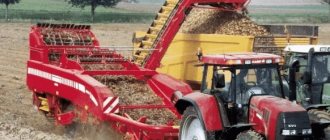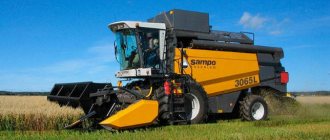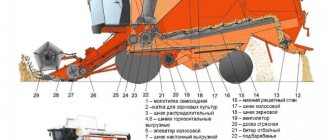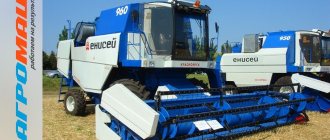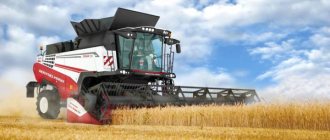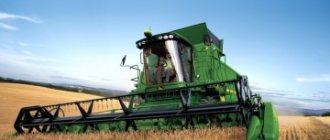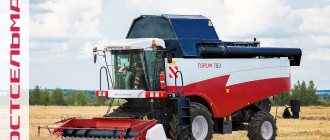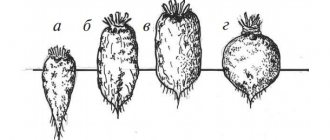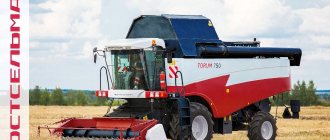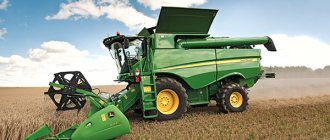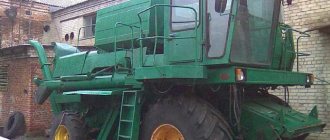Operating a Potato Harvester
The equipment is controlled from the cab or using a remote control. Guide mechanisms and collection systems allow the process to be fully automated. Modern models have special indicators, thanks to which the ridges are precisely adjusted to lift and remove vegetables from the ground. The types differ in the principle of harvesting. For example, the Grimme DR 1500 model is equipped with an elevator that allows you to transport the harvested potatoes to a nearby truck. The presence of special installations (sifting conveyor and topping rollers) ensures high-quality removal of plant residues and soil.
Carrying out repair work
The cost of maintenance and repair of Grimme combines depends on the characteristics of the equipment and its year of manufacture. The latest modifications are expensive; their parts require significant purchase costs. For example, for a used potato harvester Grimme SE 75 30 the price is set in the range from 800 thousand rubles to 1.5 million rubles. Its restoration will require minor investments. Equipment with a price of 3-4 million rubles or more is characterized by expensive maintenance. After purchasing a used old model, repairing it and bringing it to a fully operational state may require about 50 thousand rubles.
Productivity of special equipment
The efficiency of equipment is determined by the speed of processing areas and the amount of fuel consumed to complete tasks. The following information will help you find out which Grimme potato processor is the most profitable to buy:
- model type (elevator combines stand out for their maximum productivity);
- direction of digging (for lateral digging, the harvesting tractor can be located on the side of the treated area);
- power of equipment (determines the speed of movement and processing of areas);
- the separating devices used (affect the purity of the harvested vegetables);
- features of knives (the possibility of their use on different types of soil, accuracy in collecting root crops).
Before the actual harvesting, you will need to use a specialized type of combine - topper. They allow the top of the vegetation to be trimmed, allowing the potatoes to be easily accessible and harvested.
Potato harvesters Grimme Landmaschinenfabrik GmbH and Co. KG (page 1)
Potato harvesters
Grimme Landmaschinenfabrik GmbH and Co. KG
Grimme
DR-15
Designed for mechanized potato harvesting in a gentle mode. Low damage to tubers is achieved due to rubberized metal parts in conveyors, small levels of height difference and slow circulation of all separating organs. High productivity is ensured thanks to double-row harvesting (working width 1.5), high throughput and sifting with minimal noise and low vibration. With additional equipment, it is possible to use a combine harvester for harvesting beets, carrots, and onions
Specifications
| required tractor power, l. With. | from 80 |
| productivity, ha/hour | 0,8-1,1 |
| operating speed, km/h | 5-7 |
| cleanliness of a heap of tubers | 85-98% |
| tuber losses | no more than 3% |
| Hopper capacity, kg | 4500 |
| weight, kg | 7500 |
Grimme
SE 75-40
Single-row potato harvester. Lateral digging of ridges with a stretching receiving device. Unloading height up to 3.75 m, bunker capacity 4.0 t, alarm for the driver, it is necessary to connect to the tractor with a reverse hydraulic system, without pressure, a mechanically driven 2nd belt with rubber strips and a finger-shaped dumping belt driven from the tractor hydraulic system, with speed control , with cleaning rollers, impurity belt and groove with hydraulic valve solenoid valves
Specifications
| Dimensions, m, transport/working | |
| Length | 8,4/8,4 |
| Width | 3/4,65 |
| Height | 3,15/3,15 |
| Weight, t | 4,8 |
| Hitch | Traction eye or auto-lock, hydraulic control |
| drive unit | Cardan with slipper clutch, PTO maximum 540 rpm |
| Tires | 16.0/70-20 |
| Receiver | - side digging - vertical discs with spring suspension, choice of distance: 54, 58.62 cm - blade-shaped plowshares, choice of 2 or 3 parts - ridge drum 41 cm wide for receiving 54 cm, or 45 cm for reception 58.62 - 2 topping rollers, diameter 40 cm |
| Screening | |
| 1st screening conveyor | Width 75 cm, length 200 cm, rods with a diameter of 9 mm, optional distance between rod centers 35, 40, 44, 50 mm |
| 2nd screening conveyor | Width 75 cm, length 235 cm, rods with a diameter of 8 mm, pitch 32, 40, 44 mm to choose from |
| Tops department | |
| Coarse tops conveyor | |
| Width, cm | 85 |
| Length, cm | 420 |
| Separation | |
| 1st separating device | Longitudinal conveyor with rubber lugs and paired rollers, mechanical drive, adjustable tilt |
| Width, cm | 90 |
| Length, cm | 185 |
| 2nd separating device | Conveyor with rubber lugs, mechanical drive, tilt and height adjustable |
| Width, cm | 65 |
| Length, cm | 127 |
| Bulkhead table | |
| Sorting conveyor, cm | 68 |
| Conveyor for impurities, cm | 34 |
| Platform | Double-sided for at least 2+2 people |
| Drive unit | stepless hydraulic |
| Hopper with bottom conveyor | |
| Unloading height, m | 3,85 |
| Capacity, kg | 4000 |
| With filling optimization, kg | 4300 |
| Drive unit | Hydraulic |
| hydraulics | Electromagnetic control device |
Grimme
SE 75-3 0
Potato harvester SE 75-30 UB (lateral digging of ridges with a stretching receiving device, alarm for the driver, connection to the tractor with a return hydraulic system without pressure, mechanically driven 2nd belt with rubber strips and driven from the tractor hydraulic system is required finger-shaped discharge belt, with speed control, with a cleaning roller, a belt for impurities and a groove with electromagnetic valves of the hydraulic distributor, single-row, aggregated with the MTZ-82 tractor).
Specifications
| Dimensions, m, transport/working | |
| Length | 8,4/8,4 |
| Width | 3/4,65 |
| Height | 3,15/3,15 |
| Weight, t | 4,7 |
| Hitch | Traction eye or auto-lock, hydraulic control |
| drive unit | Cardan with slipper clutch, PTO maximum 540 rpm |
| Tires | 16.0/70-20 |
| Receiver | - side digging - vertical discs with spring suspension, choice of distance: 54, 58.62 cm - blade-shaped plowshares, choice of 2 or 3 parts - ridge drum 41 cm wide for receiving 54 cm, or 45 cm for reception 58.62 - 2 topping rollers, diameter 40 cm |
| Screening | |
| 1st screening conveyor | Width 75 cm, length 200 cm, rods with a diameter of 9 mm, optional distance between rod centers 35, 40, 44, 50 mm |
| 2nd screening conveyor | Width 75 cm, length 235 cm, rods with a diameter of 8 mm, pitch 32, 40, 44 mm to choose from |
| Tops department | |
| Coarse tops conveyor | |
| Width, cm | 85 |
| Length, cm | 420 |
| Separation | |
| 1st separating device | Longitudinal conveyor with rubber lugs and paired rollers, mechanical drive, adjustable tilt |
| Width, cm | 90 |
| Length, cm | 185 |
| 2nd separating device | Conveyor with rubber lugs, mechanical drive, tilt and height adjustable |
| Width, cm | 65 |
| Length, cm | 127 |
| Bulkhead table | |
| Sorting conveyor, cm | 68 |
| Conveyor for impurities, cm | 34 |
| Platform | Double-sided for at least 2+2 people |
| Drive unit | stepless hydraulic |
| Hopper with bottom conveyor | |
| Unloading height, m | 3,85 |
| Capacity, kg | 3000 |
| With filling optimization, kg | 3300 |
| Drive unit | Hydraulic |
| hydraulics | Electromagnetic control device |
Grimme
SE 150 -6 0
Lateral digging of ridges using a digging mechanism with spring-loaded coulter discs and ridge compaction drums, dividing strip for tops, drawbar attachment for the drawbar/Hitch (under the PTO), hydraulic drawbar control, set of tires 600/55-26.5, first and second screening conveyors, additionally included triangular rollers (6 pcs.), coarse tops conveyor, own hydraulics to drive the separating device, sorting stands on both sides of the sorting table, sorting conveyor with hydraulic drive, attached lowering elevator. Electromagnetic control valves powered by tractor hydraulics: adjusting the drawbar, raising the openers, the attached elevator and the roller bottom conveyor. Unloading height of the roller bottom conveyor 4.20 m, 2-stage motor for unloading the hopper, alarm for the driver, brakes and lighting.
Specifications
| required tractor power | 2 - 3 thrust classes |
| Productivity, ha/hour | 0,8 |
| working width, m | 1,5 |
| loss of tubers no more than, % | 2 |
| purity of a heap of tubers, % | 85-98 |
| Hopper capacity, kg | 6000 |
| Weight, kg | 8700 |
Grimme
DR 1500
A modern two-row potato harvester allows for mechanized harvesting, with potatoes collected in a hopper.
Specifications
| Dimensions, m, transport/working | |
| Length | 8,45/9,1 |
| Width | 3,15/4,7 |
| Height | 3,8/3,55 |
| Weight, t | 6,5 |
| Tires | 500-22.5 |
| 1st screening conveyor | 1.47 m width, 3.7 m length, optional 15, 18, 20, 24, 26, 30, 35, 40 mm clearance (distance between rods) |
| 2nd screening conveyor | 1.47 m width, 120 m length, otherwise as 1st conveyor |
| 3rd screening conveyor | 1.47 m width, 1.25 m length, 20 mm clearance (distance between rods) |
| Tops department | 1 topping roller at the outputs of the 1st and 2nd sifting conveyors and an elevator for chopped grass with a division of 40/50 mm |
| Bunker, t | 4,5 |
| Required power, kW | 60 |
Varitron 200 and
270
| Due to its large volume, this material is placed on several pages: 1 |
Main characteristics
The determining parameters when choosing potato harvesters are its type, the number of rows of knives, the features of digging, and the power of the equipment. A large number of rows of diggers allows for faster processing of the site. High engine power allows you to speed up the process of moving across the field. The volume of the bunker is also important: its large capacity allows for infrequent unloading of collected root crops. The Grimme SL 800 model is optimal in all respects (has good power, productivity, low price), the characteristics of which allow you to carefully and efficiently harvest the crop without damaging it.
Technical description of the Grimme combine
Before purchasing, it becomes mandatory to study its features and technical data. Careful selection will determine the need to purchase a modification. For example, the BR 150 Grimme trailed combine is equipped with a 4.5-ton bunker and is capable of subsequent unloading to a height of up to 3.4 m. It can be connected to a tractor with a power of 80 hp or more. for example MTZ-1221. Includes three conveyors and 2 topping shafts. The operating speed is 3-5 km/h. Equipped with two rows of knives, suitable for small and medium-sized areas.
Design Features
The operating principle of the models is identical, only the type of unloading of collected root crops differs. Additionally, we can highlight the ability of the equipment to work without auxiliary vehicles (self-propelled) or to be used as a supplement (trailered).
Raising and feeding the potatoes to the peeling mechanisms is done using ridges.
They go deep into the soil by approximately 15-20 cm. Next, the conveyor sifts out the soil, and when moving the potatoes, the residual tops are separated. All removed sprouts are thrown away, and the root crops are transferred either to the equipment bunker or transported to a separate truck. Productivity is determined by the capacity and frequency of unloading of collected vegetables. For example, the Grimme SE 75 40 model has a hopper capacity of 4 tons. This modification is suitable for long-term use and ensures quick harvesting.
Pros and cons of technology
The main advantage of the technology is the ability to quickly clean large and medium-sized fields. Careful harvesting of root vegetables makes it possible to obtain high income from harvested undamaged vegetables. Other advantages of using potato harvesters include:
- ease and simplicity of control;
- economical fuel consumption;
- full automation of the harvesting process;
- Possibility of use in areas with any soil;
- good productivity (from 0.7-1 and above hectares per hour).
The only drawback of the equipment is their high cost and maintenance. Due to reliable internal systems, each model is determined by the high price of the Grimme SE 150 60 combine harvester, for example, it costs about 8 million rubles. Repairing such models requires significant costs, and scheduled maintenance must be carried out more often than other modifications. Special attention should be paid to the mechanisms that transfer root crops to the bunker. Contamination of passages or soil adhesion will lead to premature failure of the device.
Single-row potato harvester (SE 75)
Designed for harvesting potatoes, simultaneous separation of lumps, separation of tops and transportation.
SE 75-20 for small and medium-sized fields, low design, hopper with bottom conveyor with a capacity of 2000-2300 kg (can be supplied with a platform for bagging).
SE 75-30 for medium and large fields, bunker with bottom conveyor with a capacity of 3000-3300 kg.
SE 75-40 for large fields, bunker with bottom conveyor with a capacity of 4000-4300 kg.
The first short screening conveyor ensures the separation of the raised soil. At the same time, on easily separated soil there is no effect of the tubers rolling back. Feeding to the second screening conveyor occurs with a minimum height difference. The tubers are fed upward in “portions” in cells. The accompanying "active" side pins ensure smooth transport to the first separator. A tops separating conveyor moves closely above the second screening conveyor, which separates the tops from the crop flow and leaves them in the field.
The centrally located drawbar for the drawbar can be coupled above or below the power take-off shaft (optional), without the need for a high-angle universal joint.
The ridge lifter includes a two- or three-bladed ploughshare, an optimally sized ridge drum, two vertical disks suspended on springs and two rollers that tighten the tops from the side. The digging depth is fixed using a ridge drum and adjusted with a screw. Installation of vertical discs, in accordance with soil conditions and the amount of tops, is also done with a screw.
- A second separating device can be ordered at your choice:
- For SE 75-20.
- Type UB : infinitely variable hydraulically adjustable finger conveyor with cleaning roller, suitable for all types of soils with clods and limited stone content.
- Type SB : infinitely variable hydraulically adjustable brush conveyor with a passing conveyor for impurities, used in soils with a high content of stones.
- For SE 75-30/75-40.
- Type NB : infinitely hydraulically adjustable cleaning roller, suitable for light soils without stones or clods.
- Type UB : infinitely variable hydraulically adjustable finger conveyor with cleaning roller, suitable for light to heavy soils.
- Type SB : infinitely variable hydraulically adjustable brush conveyor with a passing conveyor for impurities, used in soils with a high content of stones.
The sorting conveyor with infinitely variable hydraulic speed control (width 58 or 68 cm), is placed almost horizontally on the combine (tubers do not roll back along the belt) and has a bulkhead table for at least 2 people on each side. The uniform distribution of the crop flow on the sorting conveyor ensures excellent visibility. The impurity conveyor, which rotates in parallel with the sorting conveyor, takes all the selected impurities back to the field.
The potatoes enter the bunker with a bottom conveyor along the bunker-filling conveyor. The height of this conveyor is adjusted hydraulically to the optimum height. The hopper has a soft, textured bottom, which does not damage potatoes when falling into the hopper and ensures quick unloading.
For unloading, the hopper is hydraulically raised horizontally, then the unloading side is raised at an angle. This slight inclination ensures gentle and fast unloading thanks to minimal resistance and minimal wear, because only two revolutions of the floor conveyor are necessary for complete unloading.
Large wheels (12.5/80-18 AS or 16.0/70-20) are standard equipment to reduce ground pressure and increase operational safety.
Automatic ridge guidance. The hydraulic drawbar control system, which is included in the standard equipment of the combine, uses two sensors to guide the ridge drum exactly along the ridge.
Comb pressure control system - the drum pressure is reduced. This prevents excessive compaction of the soil, which leads to additional formation of clumps in heavy and wet soils or damage to the potatoes in the presence of stones. Maintains ridge structure on light soils.
The automatic system for returning the wheels to a straight position greatly simplifies the operator’s work. Wheel rotation up to 30° to the right and left gives high maneuverability to the combine.
- Additional equipment:
- Windrow pick-up with replaceable frame for potatoes and onions;
- Device for optimal filling of the hopper - moves away automatically as it is filled (the capacity of the hopper increases by 300 kg);
- Bunker for stones. If necessary, the hopper valve can remain open and impurities are thrown back onto the field;
- 3-roller pre-cleaning. Located behind the second cleaning device, the distance between the rollers is steplessly adjustable (0-40 mm);
- Automatic bunker filling;
- Device for separating small potatoes;
- Hopper with bottom conveyor for small potatoes (only for SE 75-30);
- Device for leveling the tilt of the machine;
Buying a Grimme combine
The possibility of purchasing equipment is determined by its cost and efficiency.
Supported models are available to companies that own small potato growing businesses. The new technology is available mainly to large trading companies with large areas for planting potatoes. When working in small areas and fields, the equipment will not be able to fully pay for itself in the shortest possible time. Before purchasing, it is necessary to consider the feasibility of the acquisition and the investment in its maintenance. It is also important to take into account the self-propelled nature of the model and the presence of a bunker. Including cabins and storage in the design allows you to save on the purchase of additional equipment or its rental. The optimal solution for large companies will be the Grimme Maxtron 620 model. The modification is suitable for working in the most difficult conditions. It has high capacity (22 tons) and maneuverability. Equipped with special protection and warning systems. Such models will ensure ease of use and allow you to quickly and efficiently collect potatoes in any field. A significant advantage of the technology is its thoughtfulness and versatility. Such modifications will become indispensable on the field and will help to significantly increase the company’s income by automating the process of harvesting the seasonal harvest.
Design and principle of operation
The Grimme combine is produced by a German company that, in addition to potato harvesting equipment, produces machines for sowing and harvesting beets, carrots, cabbage and onions, as well as ridge formers. The equipment is supplied to many countries around the world. The combine performs many functions at the same time. The unit digs up potatoes, separates the tubers from the tops, puts the vegetables in a bunker, and then unloads them onto a vehicle that delivers the bunker to the required location.
The units support the lateral digging method. The ridge is located away from the main part. The digging unit consists of rollers for cutting tops and selecting the digging depth, knives and cutting discs. Potatoes with tops are fed to a belt, which delivers the tubers to the sifting unit.
Here the tops are separated, the root crop is cleared of soil, and the tubers are sorted by size. Small vegetables fall into a special compartment and then into a hopper with a movable bottom. Then the potatoes are unloaded onto transport.
Combines are characterized by high productivity. The machines have a ring elevator where the tops are collected and the tubers are perfectly cleaned. The unit includes a wide range of options, it is possible to level the tilt, the main difference from models from other manufacturers is its smooth operation. The disadvantage is the difficulty of repair, since it is difficult to find spare parts.
The machines come in single-row and double-row. The first ones are used for working in a small area. They can be used on rocky surfaces. The bunker holds 2-4 tons of potatoes. Double-row machines have a hopper capacity of 5.5-7.5 tons. Such machines cultivate large areas of land. The conveyor can be lowered. This technique is capable of operating under poor environmental conditions.
Combine harvesters for efficient potato harvesting - types and features
To harvest potatoes and other vegetable crops, specialized equipment is used, with which manual labor can be minimized while increasing productivity several times. Sowing areas are large in size, even not on an industrial scale, which is why the potato harvester is very popular at our latitudes. There are many variations, from large-sized equipment to homemade single-row potato harvesters. Which one to choose depends on the size of the field and landscape features.
Varieties of potato harvesters
Regardless of what type of equipment you prefer, a homemade potato harvester made by yourself, or a professional unit developed by highly qualified engineers, the main difference will be in the principle of execution:
- Trailed – large-sized equipment.
- Mounted – potato harvester for mini tractor.
The main unit is a device for uprooting tubers, which has an adjustable insertion depth and tilt angle. Thanks to these plates, a layer of soil is removed directly from the potato tubers. Along the transport conveyor, all this mass is sent to the screening hopper, where the potatoes will not only be cleared of tops and soil, but also sorted by size. Small potatoes are immediately sifted out, and only after that the crop ends up in the unloading tank. The potato harvester can be equipped with a double hopper unloading system. It is worth noting that even compact models operate with a minimal percentage of crop loss.
Popular models
Today, both domestic and foreign brands are represented on the agricultural machinery market, and without restrictions you can find instructions for constructing a potato harvester with your own hands. Here are some popular equipment modifications:
KPK2
The KPK 2 potato harvester can operate in areas where potatoes are planted in rows spaced at a distance of up to 70 centimeters. The soil can be of medium or high humidity. The KPK 2 01 potato harvester should not be used where there are a large number of stones whose diameter exceeds half a centimeter. The presented potato harvester is compatible with DT and MTZ tractors.
Anna
The Anna potato harvester belongs to the mini-harvesters that can be combined into the “Dwarf” group. Despite this, a trailed type of fastener has been developed for the equipment.
